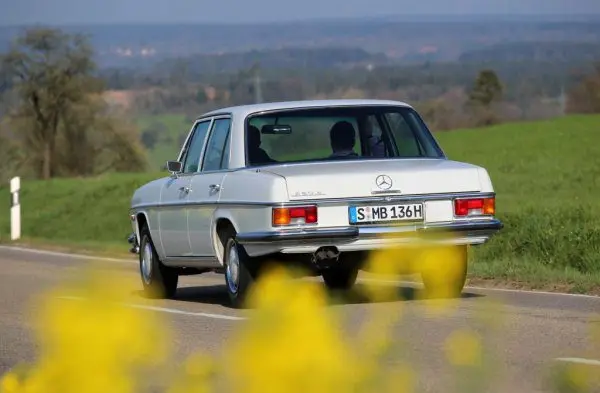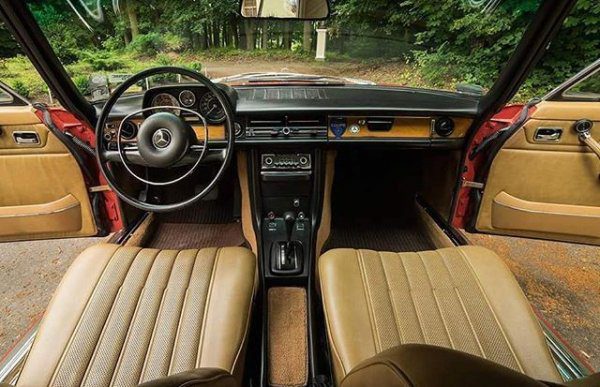
A director's dream: the history of the Mercedes E-class
Content
- 1926: W2, the first "prestigious" Mercedes
- 1936: The first passenger car with a diesel engine
- 1946-1955: from 170 V to 170 DS
- 1952-1962: W120, "Pontoon"
- 1961-1968: W110, Fins
- 1968-1976: W114, dash 8
- 1976-1986: W123 legend
- 1984-1997: W124, the first real E-Class
- 1995-2002: W210, "four-eyed" E-Class
- 2002-2009: W211
- 2009-2016: W212
- 2016-2020: W213
When it comes to executive sedans, the first thing that comes to mind is the Mercedes-Benz E-class. The letter "E" appeared in the name of the model in 1993, with the W124 generation, which does not say how rich the history is.
But in fact, Mercedes' business model dates back to 1926. As the facelift of the current generation prepares to enter the showrooms, let's remember where the tradition of the "director's dream" began in the Daimler lineup.
1926: W2, the first "prestigious" Mercedes
At the Berlin Motor Show, Mercedes is showcasing a brand new mid-size model with a 2-liter six-cylinder engine, the W8, also known as the Type 38/XNUMX. This is practically the first model released by the newly created Daimler-Benz after the merger of two previously separate companies. The car was developed in a very short time by then Daimler CTO Ferdinand Porsche. Due to constant pressure from above, Porsche fell out with company director Wilhelm Kessel, and his contract was not renewed.

1936: The first passenger car with a diesel engine
Three years after its debut, the W2 has been redesigned and is now called the Mercedes-Benz Typ Stuttgart 200. It retains the 1998 cc engine and 38 horsepower, but the compression ratio has been increased from 5: 1 to 6,2: 1, Zenith carburetor was replaced by a Solex, and a four-speed gearbox is available as an option instead of the standard three-speed gearbox. The range includes variants 200 (W21), 230 (W143) and 260 D (W138), which appeared in 1936 as the first passenger car with a diesel engine.

1946-1955: from 170 V to 170 DS
Daimler-Benz is one of the fastest recovering German automakers since the war. Already in 1946, the company resumed the production of passenger cars with pre-war 170 V (W136) engines, but modified for the needs of the police, rescue services, etc. A year later, the 170 S (W191) appeared, the first completely post-war model, still having 38 horsepower. Only in 1950 was it increased to 44 horsepower.

The economy is slowly recovering, and demand is growing, so Mercedes expanded the 170 series. In 1949, the diesel 170 D was released, and a year later, the 170 S Saloon, two versions of the convertible. In 1952, the diesel 170 D was released, followed by the 170 SV and 170 SD. The latter remained in production until 1955.

1952-1962: W120, "Pontoon"
When the first photographs of the prototype of the future Mercedes 1952 (W180) were published in 120, the German edition of Das Auto, Motor und Sport also placed a parody of Goethe's famous poem "The Forest King" (Erlkonig). That is why in Germany the model is often called the Forest King. However, it is even better known as the “pontoon” because of its innovative three-dimensional architecture and stately forms.

With much better aerodynamics than older models, an innovative suspension and a more efficient 1,9 horsepower 52-liter engine, the car is in growing demand. In 1954, six-cylinder versions appeared, as well as the 180 D.
In 1956, the first 190 rolled off the assembly line - a higher version of the car, with 75 horsepower, then increased to 80.
In total, 443 four-cylinder pontoons were sold worldwide - a very good achievement for those years.

1961-1968: W110, Fins
In Germany this model is called the Heckflosse (“fin” or “propeller”) because of the specific design of the rear end. The successor to Pontoon kicks off Mercedes' long tradition of safety innovation. The car has a protected interior and special zones to absorb energy in the event of an impact. In 1963, more efficient disc brakes were introduced to the front wheels, and in 1967 a telescopic steering wheel was installed, which also absorbs energy in the event of a collision.

The W110 family originally consisted of the 190 D petrol and 190 D diesel, followed by the 200, the 200D and the 230 six-cylinder with an impressive 105 horsepower for the era. The most powerful models also get extended versions, including station wagons. Options include things like power steering, glass roof, heated rear window, air conditioning, automatic transmissions and power windows.

1968-1976: W114, dash 8
In the late 1960s, the company finally distinguished between its business segment models and luxury sedans, which were still called S-models.
In 1968, the Fin's successor, W114, appeared, the appearance of which was painted by the legendary French designer Paul Braque. In Germany, this car and its sister W115 are called "Strich Acht" - "oblique eight", because "/8" appears in their code name.
It is the first Mercedes model to have sold over 1 million units (in fact, 1976 million sedans and 1,8 coupes had been assembled by the end of production in 67).

Code W114 is used for six-cylinder engines, and W115 for models with four or five cylinders. The most memorable are the Bosch fuel-injected 250 CE with 150 horsepower, and the 280 E with up to 185 horsepower.
Technologically, this car is much more modern than the "Fin" - with a stabilizer bar, a five-speed transmission, central locking and alloy wheels. Then there are inertial seat belts and head restraints.

1976-1986: W123 legend
In 1976, Mercedes finally introduced the successor to the W114, designated the W123. This car immediately became a market sensation, mainly due to the seductive design of Bruno Saco. The interest is so great that the car has been waiting for more than a year, and in the secondary market, little-used W123s are more expensive than new ones. The model quickly improved on the performance of its predecessor and by the end of its production in 1986 had sold over 2,7 million units. Taxi drivers in Germany are massively redirected to it, since the engines can easily cover 500 and even 000 km without major repairs.
It is also the first model with an official station wagon version - up to this time it was only an additional modification, especially at the Belgian IMA plant.

The W123 comes with a truly impressive engine selection, ranging from 55 to 177 horsepower. Of note is the 300 TD variant, with a turbodiesel unit and 125 horsepower. Experimental versions with an electric and hydrogen power plant have also been developed.
For the first time in this model, ABS, an anti-shock tank, a driver's airbag and cruise control are available as optional extras.
The car proves its worth in the epic London-Sydney Rally, where two 280 E's are in the top two and the other two are in the top ten.

1984-1997: W124, the first real E-Class
The W124 generation, which debuted in 1984, was the first to officially receive the E-Class designation, although it did not receive it until near the end of the model's life, in June 1993. The prototype was developed by Halicendorfer and Pfeiffer, and the production model by the user Bruno Sako. The W124 is available in four variants: sedan, station wagon, coupe and convertible, as well as an extended version and a range of special models.

The choice of petrol and diesel units has been further expanded, with power now ranging from 72 to 326 horsepower (in the top 500 E since 1990). A little later, the E 60 AMG appeared with 381 horsepower, 4Matic all-wheel drive and multi-link rear suspension. In just 13 years, 2,737 million vehicles were produced.

1995-2002: W210, "four-eyed" E-Class
Work on the successor to the W124 began in the late 80s. Designed by Steen Mateen under the direction of Bruno Sako. We will remember this car as a "four" because of the two pairs of round headlights on the front.
This E-Class, known under the code W210, is larger and more luxurious than the previous one.
This is the first Mercedes to feature xenon headlights with automatic beam length adjustment.

The choice of engines is still rich, from 95 to 347 horsepower. In 1998, the then sixes were replaced by an all-new V6, code M112, with a maximum output of 223 horsepower and 310 Nm of torque. Early models had a 4-speed transmission, while those after 1996 had a five-speed.
Unfortunately, the E210 will also be remembered for its dramatic change in quality, the result of then-Daimler boss Jurgen Schremp's idea to cut costs. Cars of this generation are known for a number of defects - from problems with the flywheel, air sensor, melting of the rear lights, failure of window mechanisms, to frequent rust on the doors and even on the hood emblem.

2002-2009: W211
The problems of the W210 carry over to the successor W211 introduced in 2002. This model is an evolution of the previous car, introducing bi-xenon headlights, automatic air conditioning, automatic rain-sensing wipers and many other technologies. The car has four-point suspension at the front, multi-link suspension at the rear and, as an option, pneumatic suspension adjustment. It is also the first E-Class to feature an electronic stability program (ESP) as standard.

With the firing of Schremp and his replacement by Dieter Zetsche in 2006, the company again began serious efforts to improve production quality, and the latest versions of the W211 are considered significantly better assembled than the previous ones. After the facelift, the E63 AMG version appeared with a maximum power of 514 horsepower.

2009-2016: W212
In 2009, the W211 was finally discontinued and replaced by the W212 with a Thomas Stopka design, which is remembered mainly for its unusual split headlights. However, the new platform was only used for the sedan and station wagon, while the coupe and convertible versions were based on the C-class (W204).

In 2013, Mercedes did a facelift, but in fact, in terms of the scale of changes and investments in development (more than 1 billion euros), it was rather a completely new model. The company itself claims that this is the "most significant refinement" of the model they have ever made. The controversial quad headlights are gone, and new head designer Gordon Wagener has brought the E-Class into harmony with the rest of the lineup.

2016-2020: W213
The current generation debuted in Detroit in 2016. Its exterior, designed by Robert Lesnick under Wagener's leadership, now ties it more closely to the C-Class and S-Class. It is also the most technologically advanced executive sedan in Mercedes history, with the ability to turn and even overtake on the highway and then return to its lane.

This year, the E-Class has received a facelift that will debut in most markets in late fall or early 2021. The design changes are modest, but the powertrain is quite serious - the introduction of 48-volt hybrid technology for gasoline engines, two gasoline and new diesel plug-in hybrids. The old Command information system has been replaced with MBUX developed by Visteon's subcontractor's Sofia office.
